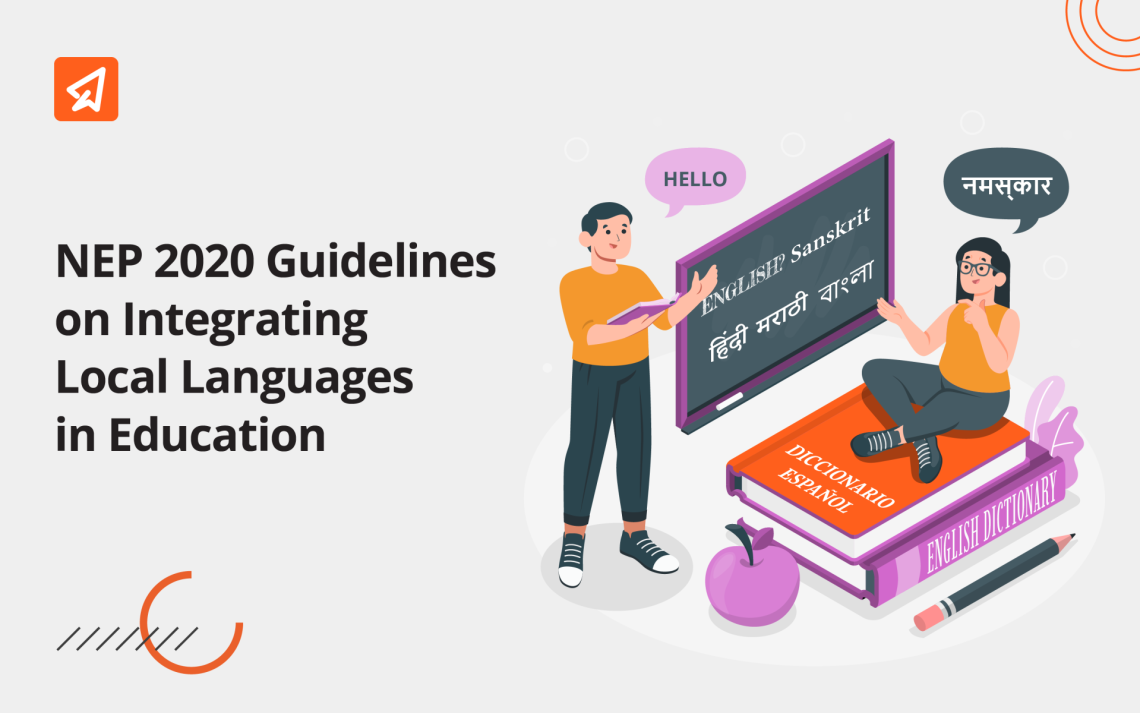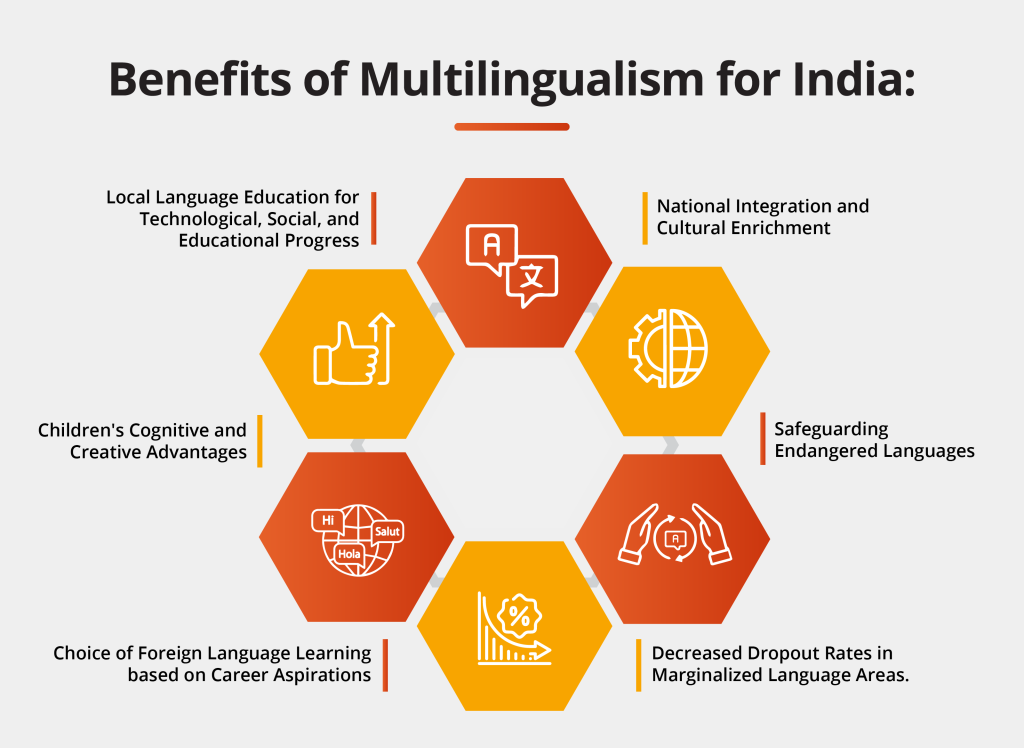NEP 2020 Guidelines on Integrating Local Languages in Education

India has deep cultural roots that have been enhanced through languages, arts, literature, customs, traditions, heritage sites, etc. Culture has been largely documented through conversations among people speaking a common language. Multilingualism is where the language spoken at home by family members may be different from the local language. Research shows that children find it easier to understand conceptual information in their local language.
The National Education Policy, 2020 (NEP 2020) aims at promoting multilingualism through English and local languages, as well as highlighting the importance of languages of India through teaching and learning.
What is Multilingualism under NEP 2020?
Through NEP 2020, the government intends to introduce the local language at the foundation and primary school stage. This policy is of the opinion that a language need not be a medium of instruction for it to be learned well and hence every effort would be made to teach all languages across the country with the highest quality.
Implementation of multilingualism under NEP 2020
According to research, children grasp languages quickly up to the age of 8 years. Learning multiple languages has cognitive benefits, especially at the foundational stage. NEP 2020 promotes multilingualism, wherein it will be the choice of the state and the students as to which language is to be learned, as long as two of the three languages are native to India.
Let us find out how schools and teachers would be affected by multilingualism under NEP 2020.
1. Medium of instruction: As far as possible, the medium of instruction until at least class 5 would be the local/regional language and until class 8 wherever possible. Beyond this, the local/regional language shall continue to be taught in addition to the main language of instruction
2. Activity-based learning: All languages would be taught through interactive activities with reading and writing from an early age
3. Learning material: High quality textbooks, for other subjects, would be made available in regional languages, thus fulfilling the government’s aim of having national textbooks with local flavour. Where textbooks may not be available in the regional language of the student, every effort would be made to keep the child’s mother tongue as the conversational language between the teacher and student
4. Students’ choice: Students may change one or more of the three languages in class 6 or 7 so far as basic proficiency in the languages is demonstrated by the end of secondary school
5. Development of teachers: Central and state governments shall work towards developing language teachers for all regional languages, specially for the 22 mentioned under the eighth schedule of the Constitution of India. States may enter into bilateral agreements to hire teachers from each other to ensure multilingualism is followed
6. Higher education: Medium of instruction may be the local language in higher education institutions or programmes may be offered bilingually. Special focus would be given to departments offering bachelors programmes in Indian languages, arts, philosophy, creative writing, music, etc. and research in such areas will be funded specifically by the National Research Foundation. Hands on knowledge will be provided by roping in local artisans and craftspersons as guest faculty.
National textbooks with local flavour
NEP 2020 recommends that textbooks continue to contain the core study material and also include content based on local needs and notes. Under the policy, teachers will have a choice to pick from a set of textbooks based on their local requirements and teaching style. Such textbooks are proposed to be sold at the lowest possible price to reduce the pressure of school expenses on students. NEP 2020 also requires that such national textbooks with local flavour be developed by the Centre in association with the states, with the SCERTs formulating them in line with the National Curriculum Framework for School Education and customising for a particular state. The NEP 2020 also suggests public-private partnership funding to get subject experts to contribute to these national textbooks with local flavour.
Benefits of Multilingualism for India:

1. Cognitive and creative benefits in children
2. Education in local language important for technological, social and educational progress
3. Choice for students to learn foreign languages at the secondary stage based on career aspirations
4. Essential for national integration and cultural enrichment in the next generation
5. Safeguarding languages rated ‘endangered’ by UNESCO
6. Curb dropout rates in schools, especially in areas where local language is marginalised
Emphasis on online education
1. Web-based portal: Under NEP 2020, a web-based platform/portal is proposed to be developed for documenting all Indian languages and related arts and culture to preserve endangered languages of India. Such a portal will also contain recordings, stories, poetry, videos, elderly people speaking in the language, folk songs, dictionaries, etc. Universities, colleges and researchers from all over India would be encouraged to build and enrich such a portal
2. Affordable technology: There will be concurrent efforts for making access to technology affordable to ensure parity in online education through campaigns such as Digital India
3. Online teaching: Emphasis is being laid on providing required training to teachers to become effective at online teaching through usage of tools such as Smart Class Solution that facilitate online delivery for teachers and make the process easy and enjoyable
4. Assessments: Assessments would be a balanced mix of online examinations and offline experiential and practical learning as may be required. Schools will make use of online test templates and also create online tests that may be shared offline, maintain online records of students’ performance and have AI based platforms for analysis of results through offerings such as Extramarks’ Assessment Centre
What is Ek Bharat Shreshtha Bharat Scheme?
With this intention of forging a sustainable cultural and organised ties among citizens of different states, Hon’ble Prime Minister Shri Narendra Modi, on the occasion of Rashtriya Ekta Divas on October 31 2015, to commemorate the birth anniversary of Sardar Vallabhbhai Patel, proposed the idea of a continuous give and take between people belonging to different states. The Ek Bharat Shreshtha Bharat Scheme was launched to give shape to this idea.
What are some features of the Ek Bharat Shreshtha Bharat Scheme?
Under the Ek Bharat Shreshtha Bharat (EBSB) scheme, every state and union territory would be paired with another for a year during which they would engage in a defined exchange in the areas of festivals, languages, cuisine, literature, tourism, etc.
Objectives and Vision of Ek Bharat Shreshtha Bharat Scheme
1. Celebration of unity in diversity and strengthening of emotional bonds
2. Promotion of learning through exchange of best practices and national integration through engagement between states & union territories (UTs)
3. Showcase rich heritage and customs & appreciate diversity
Vision of the Ek Bharat Shreshtha Bharat Scheme
1. Brotherhood amongst citizens and awareness of interconnectedness by way of interaction through literature, festivals, music, dance, movies, food, wildlife, etc.
2. Feeling of familiarity among people while traveling to different states of the country
3. Sense of responsibility towards the country, as a whole, through interdependence among states
4. Celebration of unity in diversity and appreciation of different value systems present across the country
How will the Ek Bharat Shreshtha Bharat scheme apply to schools?
1. Fun project/activity: A specific activity would be undertaken during classes 6 to 8 to understand the similarities found in various Indian languages with respect to their scripts, alphabets, phonetics and origin of vocabulary from the Sanskrit language. Such activity would not have any assessment and would be undertaken for students to feel a sense of unity in a fun way
2. EBSB clubs: Clubs would be formed at the middle/secondary stage by schools belonging to state boards, ICSE, CBSE, Kendriya Vidyalaya, etc. with the goal of spreading awareness of languages of the paired states/UTs
3. Student travel: Students will be encouraged to travel to different parts of the country to get first-hand knowledge of the diversity in India and understand the culture, customs, history, etc. 100 destinations for such travel would be identified under the EBSB scheme
4. Preparation of 100 sentences: SCERTs, in association with paired states/UTs, will come up with 100 sentences in their languages in the form of phrases, proverbs, songs, etc. and such sentences would be uploaded on the websites of schools for easy access by students
Conclusion
India has a vast variety of languages, traditions and customs that are seen through festivals, cuisines, heritage sites, artefacts and art across the country. Awareness and promotion of the languages and cultures is not only important for national integration, but also to build a sense of belonging, pride and appreciation of other cultures among children. NEP 2020 and schemes such as Ek Bharat Shreshtha Bharat have realised this need and have laid down actionable steps and programmes that are to be implemented across the education spectrum and otherwise. Strong infrastructure, in the form of competent teachers, accessible and robust technological setups, high quality degree programmes and quality textbooks are being devised and put in place to further the cause of multilingualism and cultural awareness.
FAQs
Q. How will students moving to different parts of the country during their school years cope with learning local languages?
Ans: The emphasis on having local language as the medium of instruction is only until class 5. Children are known to grasp languages quickly up to this age. Post class 5, while local languages would continue to be a part of the curriculum, the medium of instruction may be changed to English, thus giving a common ground for students moving across the country.
Q. Will textbooks be available in English at the foundation stage as well?
Ans: Textbooks will be available in English and the local language, in case of it being the medium of instruction, throughout the school years.
Q. Where can I find the detailed Ek Bharat Shreshtha Bharat Scheme and pairing of states done under the scheme?
Ans: Below is the link for the document on the Ek Bharat Shreshtha Bharat Scheme released by the Government of India.
https://dsel.education.gov.in/sites/default/files/ebsb_guidelines_updated.pdf
Recent updates and other details regarding the scheme may be found at https://www.india.gov.in/spotlight/ek-bharat-shreshtha-bharat
Last Updated on October 10, 2024
Reviewed by

Prachi Singh | VP - Academics
Prachi Singh is a highly accomplished educationist with over 16 years of experience in the EdTech industry. Currently, she plays a pivotal role at Extramarks, leading content strategy and curriculum development initiatives that shape the future of education...read more.









